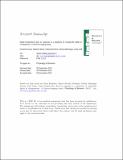Files in this item
Nasal temperature drop in response to a playback of conspecific fights in chimpanzees : a thermo-imaging study
Item metadata
| dc.contributor.author | Kano, Fumihiro | |
| dc.contributor.author | Hirata, Satoshi | |
| dc.contributor.author | Deschner, Tobias | |
| dc.contributor.author | Behringer, Verena | |
| dc.contributor.author | Call, Josep | |
| dc.date.accessioned | 2016-12-05T00:33:03Z | |
| dc.date.available | 2016-12-05T00:33:03Z | |
| dc.date.issued | 2016-03-01 | |
| dc.identifier | 237812083 | |
| dc.identifier | 238e07b2-ca8b-487e-b55d-3ae4c1e63b2c | |
| dc.identifier | 84949659144 | |
| dc.identifier | 000369455200011 | |
| dc.identifier.citation | Kano , F , Hirata , S , Deschner , T , Behringer , V & Call , J 2016 , ' Nasal temperature drop in response to a playback of conspecific fights in chimpanzees : a thermo-imaging study ' , Physiology & Behavior , vol. 155 , pp. 83-94 . https://doi.org/10.1016/j.physbeh.2015.11.029 | en |
| dc.identifier.issn | 0031-9384 | |
| dc.identifier.other | RIS: urn:A9DBD31EDCAD0C20FE1DF8CF4581155F | |
| dc.identifier.other | ORCID: /0000-0002-8597-8336/work/37477955 | |
| dc.identifier.uri | https://hdl.handle.net/10023/9930 | |
| dc.description | This study was conducted in part under the first author's postdoc program; the Japan Society for Promotion of Science (JSPS) for study abroad. FK and SH respectively received JSPS KAKENHI Grant Number 26885040 and 26245069. This study was also in part funded by JSPS MEXT KAKENHI Grant Number 24000001, JSPS-LGP-U04, JSPS core-to-core type A CCSN, and MEXT-PRI-Human Evolution. | en |
| dc.description.abstract | Emotion is one of the central topics in animal studies and is likely to attract attention substantially in the coming years. Recent studies have developed a thermo-imaging technique to measure the facial skin temperature in the studies of emotion in humans and macaques. Here we established the procedures and techniques needed to apply the same technique to great apes. We conducted two experiments respectively in the two established research facilities in Germany and Japan. Total twelve chimpanzees were tested in three conditions in which they were presented respectively with the playback sounds (Exp. 1) or the videos (Exp. 2) of fighting conspecifics, control sounds/videos (allospecific display call: Exp. 1; resting conspecifics: Exp. 2), and no sound/image. Behavioral, hormonal (salivary cortisol) and heart-rate responses were simultaneously recorded. The nasal temperature of chimpanzees linearly dropped up to 1.5. °C in 2. min, and recovered to the baseline in 2. min, in the experimental but not control conditions. We found the related changes in excitement behavior and heart-rate variability, but not in salivary cortisol, indicating that overall responses were involved with the activities of sympathetic nervous system but not with the measureable activities of the hypothalamus-pituitary-adrenal (HPA) axis. The influence of general activity (walking, eating) was not negligible but controllable in experiments. We propose several techniques to control those confounding factors. Overall, thermo-imaging is a promising technique that should be added to the traditional physiological and behavioral measures in primatology and comparative psychology. | |
| dc.format.extent | 12 | |
| dc.format.extent | 732354 | |
| dc.language.iso | eng | |
| dc.relation.ispartof | Physiology & Behavior | en |
| dc.subject | Aggression | en |
| dc.subject | Emotion | en |
| dc.subject | Great ape | en |
| dc.subject | Skin temperature | en |
| dc.subject | Thermo-imaging | en |
| dc.subject | BF Psychology | en |
| dc.subject | DAS | en |
| dc.subject.lcc | BF | en |
| dc.title | Nasal temperature drop in response to a playback of conspecific fights in chimpanzees : a thermo-imaging study | en |
| dc.type | Journal article | en |
| dc.contributor.institution | University of St Andrews. School of Psychology and Neuroscience | en |
| dc.contributor.institution | University of St Andrews. Centre for Social Learning & Cognitive Evolution | en |
| dc.identifier.doi | https://doi.org/10.1016/j.physbeh.2015.11.029 | |
| dc.description.status | Peer reviewed | en |
| dc.date.embargoedUntil | 2016-12-04 | |
| dc.identifier.url | http://www.scopus.com/inward/record.url?scp=84949659144&partnerID=8YFLogxK | en |
This item appears in the following Collection(s)
Items in the St Andrews Research Repository are protected by copyright, with all rights reserved, unless otherwise indicated.

